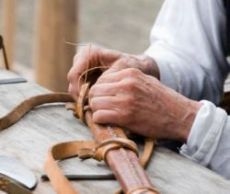Whip Up a Treasure or Two Out of Leather

People have been working with leather for so long that there are no historical records of the beginnings of leather craft. Until recent historical times most households would have a few basic leather tools such as punches, awls, and various leather working needles , even if no one in the household pursued any type of leather working as a hobby. In recent years, however, it has become increasingly difficult to even find basic leather working tools and supplies.
Many different types of craft projects are suitable for leather and can develop into a enjoyable hobby. Wine bottles can be covered with leather to produce either candle holders or flower holders. Simple braided strips can make key holders while keeping idle hands busy. More advanced braiding projects can include expensive bull-whips, quite useful for cattle ranchers in Southern pine forests (hence the term "cracker"). Sewing projects can be either hand stitched or machine stitched and elaborate or simple.
Traditional leather carving projects can be as simple as a carved leather coaster or as complex as a western saddle. Complete kits for purses, wallets, hats, or even saddles can be purchased, along with basic tool kits. Search "leather craft" online to find sources. If a local introductory class is available it would be advisable to take advantage of the opportunity to get some experience before undertaking a serious project, but it is reasonable to just jump into some simple project on your own.
Hand made leather leather objects can make excellent gifts. Because of their personal character, these types of gifts often become treasured gifts. If you are at all artistic you should consider either copying existing art-work, such as graphic art by Beardsley or Escher, or perhaps tattoo flash. Imagine a carved leather purse with a matching pattern for a woman with a prized tattoo, or a leather vest matching your biker buddy's body-art.
Using original art requires first creating a pattern of the cut lines on water resistant tracing paper or plastic. Most hobby or art shops will have tracing materials. The carving leather is first cased, which means it is moistened (not wet) and allowed to settle in for a short while. The leather should be covered to prevent drying. Uncover the leather and allow the surface to dry to a barely damp state. The pattern is positioned on the leather and the lines traced with a stylus to create a visible impression of the design on the leather.
Those lines are then cut into the leather with a special knife called a swivel knife. If you are using delicate leathers such as unborn calf or lamb, be careful. When completing the design with beveling, shading, or special design stamping tools, keep in mind the thickness of the leather. Be sure that whatever finishing techniques are employed are appropriate and properly done. Don't attempt new techniques on a valuable project. You want your hand made project to be a treasured gift for many years.
